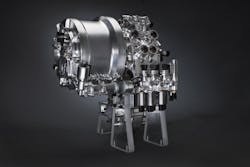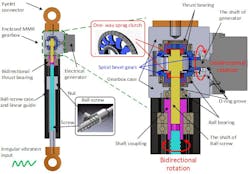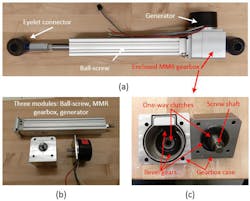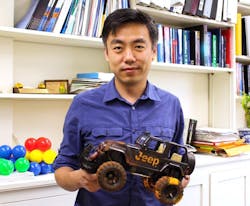>> Website Resources
.. >> Library: TechXchange
.. .. >> TechXchange: Power Management
.. .. .. >> Topic: Energy Harvesting
Car manufacturers worldwide are turning to leading-edge technologies, spending money and time on R&D developments and partnerships on energy-harvesting and regeneration efforts, just to stay competitive with the emergence of smarter cars. They’re motivated by the need to rein in high costs of battery power for hybrid-electric vehicles (HEVs) and mild HEVs (MHEVs), lower overall car prices, better energy efficiency, and the greater popularity of eco-friendly green manufacturing. These efforts are even more popular in European and Asian markets, where kinetic energy recovery systems (KERSs) are being pursued and refined.
One of the most sought-after regenerative technologies is regenerative braking. Late last year, Italy-based Magneti Morelli said it will display at the Consumer Electronics Show a MHEV 48-V belt starter generator (BSG) consisting of an electric motor with integrated electronics that replaces a standard car alternator. It recuperates energy from braking to power the car’s internal combustion engine and electrical systems.
Regenerative braking takes the kinetic energy that propels a car forward, most of which is in the form of heat, and recharges the car’s battery. It’s useful when there’s a lot of stop and go driving, and has been used in Formula One race cars. It’s sometimes implemented in conjunction with anti-lock braking systems (ABS) using a controller that monitors the rotational speed of the wheels and the difference in that speed from one wheel to another. The controller also calculates how much torque (rotational force) is available to generate electricity.
Another KERS system under refinement is being used by the United Kingdom’s Torotrak Group, which acquired the UK’s Flybrid technology. It’s said to be a “smarter and more environmentally sound” way for regenerative braking than other methods. This mechanical flywheel energy-recovery system, originally used in Formula One race cars as well, targets passenger cars.
1. Torotrak’s Flybrid KERS flywheel system is aimed at passenger cars using regenerative braking. It’s presently being used in off-highway vehicles to improve fuel consumption and productivity. (Source: The Torotrak Group)
The Flybrid technology comes in a continuously variable transmission (CVT) version and a Flybrid-developed advanced clutch transmission (CFT) version (Fig. 1).
Vibrational Energy Harvesting
Harvesting energy and recovering it can also be done by converting the kinetic energy given off by auto shock absorbers. Such a process dampens the vertical vibrations of the shock absorber into rotational motion that turns a generator.
Professor Lei Zuo and his colleagues developed a mechanical motion rectifier (MMR)-based energy harvester that converts reciprocating shock-absorber vibrations into a unidirectional rotation of a generator. Only one large bevel gear is engaged to the screw shaft, at any time, becoming the driving gear. If the screw rotates counter clockwise, the lower clutch engages on the screw shaft and the lower gear drives the generator to rotate clockwise. The proposed high efficiency enables the generator to rotate at a relatively steady speed during irregular vibrations, improving system reliability by reducing impact forces in transmission gears.
2. The design of an MMR-based energy harvesting shock absorber by Virginia Tech University makes use of a ball-screw mechanism (top). The bottom image shows a prototype of the ball-screw-based MMR shock absorber (a); the overall shock absorber (b); and three independent modules (c) inside structure of MMR gearbox. (Source: IEEE/ASME Transactions on Mechatronics, Vol. 22. No. 5, Oct. 2017)
The design uses a ball-screw mechanism that consists of three modules: the ball screw, the enclosed MMR gearbox, and the generator (Fig. 2).
A more natural way of harvesting energy for cars is by electrodynamic means using magnetic induction to measure vibrations. But that requires the use of a boost-battery management chip, available on the market, with small batteries and a storage element like a supercapacitor. Jennova Inc. has developed such a module—it harvests the small amounts of energy typically lost in mechanical motion. With no moving parts, wear and tear isn’t an issue (Fig. 3).
3. This patented energy-harvesting product from Jennova Inc. simplifies the capture of energy produced from the rotation or spin of other devices to power an endless an array of smart sensors and IoT applications. (Source: Jennova Inc.)
“We have continued and increased our sales of energy-harvesting-powered automotive gauges, expanded from just automotive to include marine and heavy equipment as well as begun work with ambient wireless energy harvesting designs,” says Terry Pennisi, Jennova’s CEO and founder.
“We’re currently producing over 1.9 mW with our latest design, and begun work on further energy-harvesting-powered automotive sensors in collaboration with some large multi-national corporations. One energy-harvesting module can power up to four sensor types,” he adds.
The interesting thing about Jennova’s approach is that it’s virtually error-free. In most instances, claims Jennova, sensors operating with a maximum iteration rate of 10 minutes require a 2032-type battery that needs changing every six months. As long as there’s motion, the module creates power.
Going Triboelectric
Energy harvesting using the piezoelectric effect has been around for quite some time, but it’s now making use of the triboelectric effect as evidenced by leading tire manufacturers like Goodyear. Normally, this is used in car tire-pressure monitoring systems (TPMSs). The TPMS unit is usually mounted within the tire behind the air-valve stem.
The triboelectric effect is a type of contact electrification in which certain materials become electrically charged after they come into frictional contact with a different material like a rubber tire with the roadway. Rubbing glass with fur, or a plastic comb through the hair, can also build up triboelectricity.
But work at the University of Wisconsin-Madison on the triboelectric effect by Professor Xudong Wang and his colleagues in the materials and science lab has produced a triboelectric nanogenerator (TNG) that enables roadside energy harvesting. The TNG can be used on common surfaces like flooring, where there’s heavy human traffic.
4. Professor Xudong Wang of the University of Wisconsin-Madison holds a Jeep toy car that uses the triboelectric effect to harness energy from tire-roadway friction. Such a system can potentially save about a 10% increase in an average car’s gas mileage given a 50% friction energy conversion. (Source: University of Wisconsin-Madison)
“Regardless of the energy being wasted, we can reclaim it, and this makes things more efficient,” says Wang. It has been successfully tested on a Jeep toy car. Research has shown that the amount of energy being harvested is directly related to the weight of the car, as well as its speed. Wang estimates that about a 10% increase in an average vehicle’s gas mileage is possible given a 50% energy friction conversion efficiency (Fig. 4).
This kind of thinking about the triboelectric effect is more widespread: A team at the University of California Merced is working on a triboelectric roadway that’s being funded by the State of California. Project EPC-16-049, the “Ultra-High-Power Density Roadway Piezoelectic Energy Harvesting System,” is targeted at trucks and small vehicles.
The system consists of multilayer piezoelectric stacks integrated with power electronics. Estimations of electrical power density of 333 W/ft.2 with a vehicle speed of 60 mph are predicted based on road deformation of 2 mm or less. The status of this project can be viewed at www.ucmeri.ucmerced.edu.
The Future for The Auto Industry?
With all of this activity surrounding energy harvesting and regeneration, auto makers and their suppliers have much to think about over the next few years. They need to keep looking back over their shoulders just to stay competitive in the business.
Marketing predictions paint a challenging picture by many analysts. They forecast that over the next few years, peak annual sales of over 14 million cars that use 48-V power is expected. A massive $1 billion is projected to be spent by materials, components, systems, and vehicle developers over the years before purely electric vehicles (EVs) appear, and even then, EVs will see some competition from 48-V cars.
>> Website Resources
.. >> Library: TechXchange
.. .. >> TechXchange: Power Management
.. .. .. >> Topic: Energy Harvesting






